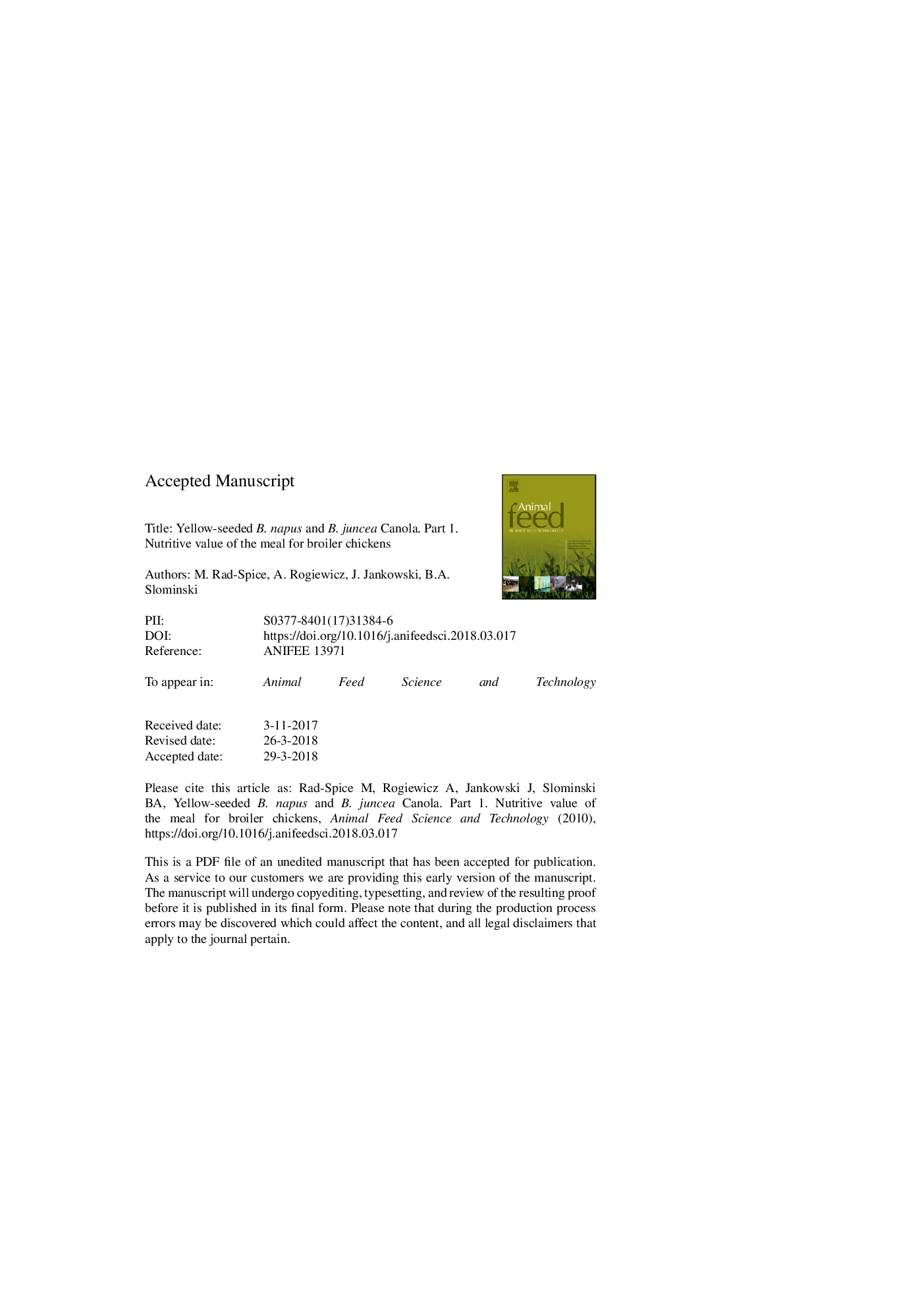| کد مقاله | کد نشریه | سال انتشار | مقاله انگلیسی | نسخه تمام متن |
|---|---|---|---|---|
| 8490962 | 1552346 | 2018 | 35 صفحه PDF | دانلود رایگان |
عنوان انگلیسی مقاله ISI
Yellow-seeded B. napus and B. juncea canola. Part 1. Nutritive value of the meal for broiler chickens
ترجمه فارسی عنوان
زردآلو بذر ناپوس و بوته یونسا کانولا. قسمت 1: ارزش غذایی تغذیه ای جوجه های گوشتی
دانلود مقاله + سفارش ترجمه
دانلود مقاله ISI انگلیسی
رایگان برای ایرانیان
کلمات کلیدی
ADFNDICPtmenTDFAMEnNDFNSPFCRBWGSBMNutritive value - ارزش تغذیه ایBody weight gain - افزایش وزن بدنacid detergent fibre - الیاف پاک کننده اسیدapparent metabolisable energy - انرژی قابل متابولیسم ظاهریChemical composition - ترکیب شیمیاییBroiler chicken - جوجه گوشتیCanola meal - غذای کانولاtotal dietary fibre - فیبر رژیمی کلneutral detergent fibre - فیبر مواد شوینده خنثیdry matter - ماده خشکfeed conversion ratio - نسبت تبدیل خوراکneutral detergent insoluble crude protein - پروتئین خام مواد نامطلوب خنثی خنثیnon-starch polysaccharides - پلی ساکارید غیر نشاستهSoybean meal - کنجاله سویا
موضوعات مرتبط
علوم زیستی و بیوفناوری
علوم کشاورزی و بیولوژیک
علوم دامی و جانورشناسی
چکیده انگلیسی
Breeding attempts to increase the oil in the seed and to reduce the fibre content in the meal have led to the development of yellow-seeded B. napus canola and canola-quality B. juncea. The objective of the current study was to evaluate the chemical and nutritive composition of meals derived from yellow-seeded B. napus and B. juncea canola in comparison with the meal from conventional black-seeded B. napus canola. Apparent metabolisable energy (AMEn) and standardised ileal amino acid digestibility (SIAAD) of the three canola meals (CM) were determined with broiler chickens of 14 to 19 d of age (AMEn assay), or 14 to 21 d of age (SIAAD assay) using 6 cages of 6 birds each per treatment. The nutritive value of CM was further validated in a 35-day performance study using 7 cages of 50 broiler chickens per treatment, including a control group without CM. Birds were fed wheat/maize/soybean meal-based diets containing 150â¯g/kg of canola meals in the starter (1-10 d), grower (11-24 d), and finisher (25-36 d) phases of the experiment. In comparison with the conventional meal, these from yellow-seeded B. napus and B. juncea contained, on dry matter (DM) basis, more crude protein (434 and 472 vs. 411â¯g/kg), more sucrose (101 and 80 vs. 66â¯g/kg), and less total dietary fibre (298 and 289 vs. 350â¯g/kg), respectively. The highest content of all essential amino acids (except cysteine) was observed in B. juncea meal. The AMEn and mean SIAAD coefficients for yellow-seeded B. napus, B. juncea canola, and the conventional black-seeded B. napus were 7.80, 8.75 and 7.96â¯MJ/kg DM, and 0.83, 0.83, and 0.82, respectively. In the growth performance study, body weight gain (BWG) was significantly lower for the yellow-seed B. napus meal as compared with the Control and the black-seed B. napus and B. juncea meals (2.19, 2.32, 2.30, and 2.31â¯kg/bird, respectively). No significant difference in feed conversion ratio (FCR) between the Control and diets containing the three CM were observed indicating that all types of CM could be used effectively and replace soybean meal (SBM) in broiler chicken rations, providing that the diets are formulated based on digestible amino acids and available energy contents.
ناشر
Database: Elsevier - ScienceDirect (ساینس دایرکت)
Journal: Animal Feed Science and Technology - Volume 240, June 2018, Pages 66-77
Journal: Animal Feed Science and Technology - Volume 240, June 2018, Pages 66-77
نویسندگان
M. Rad-Spice, A. Rogiewicz, J. Jankowski, B.A. Slominski,
